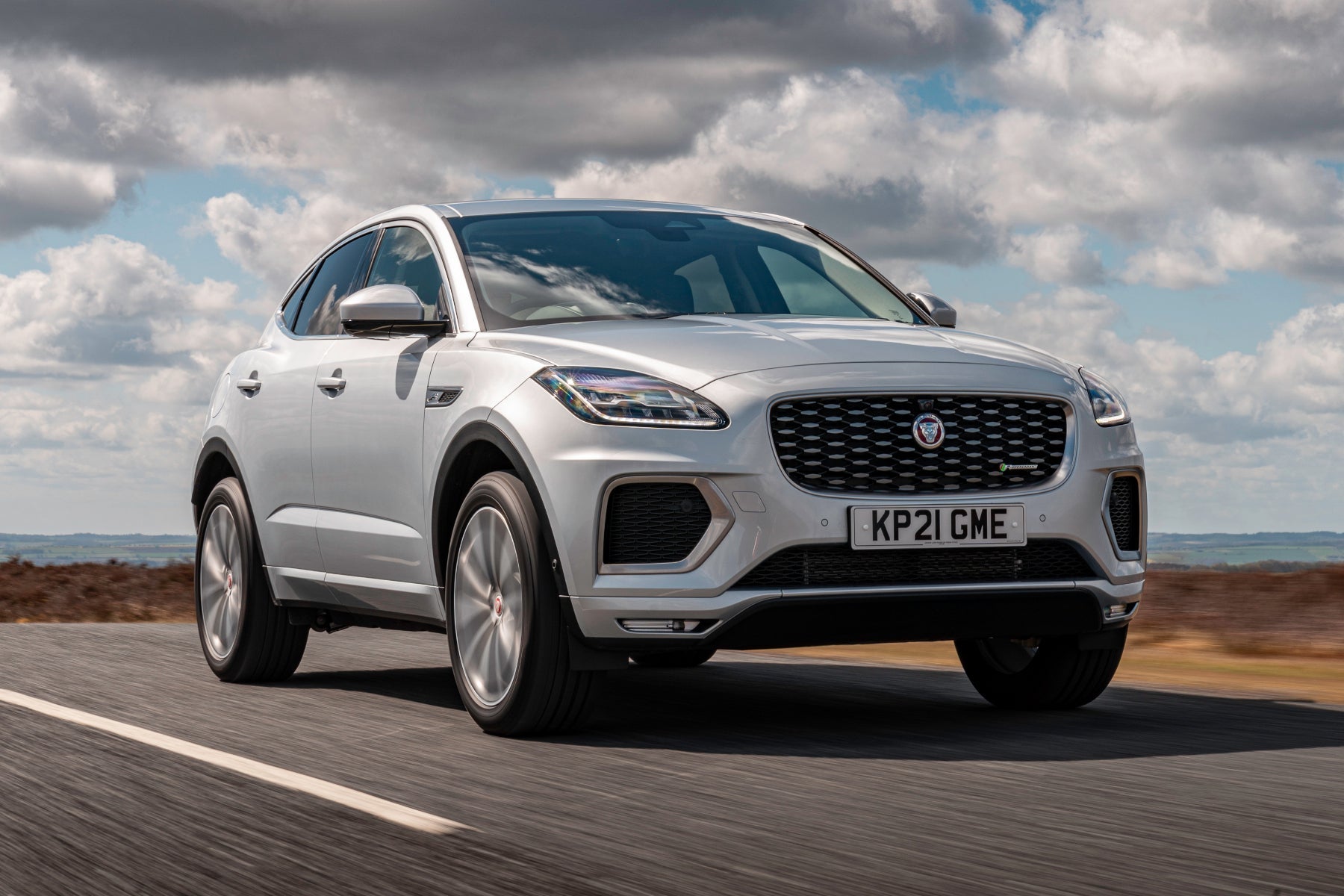Jaguar E-Pace Review 2024
Written by Andrew Brady
Quick overview
Pros
- Stylish design
- Cabin greatly improved from 2021
- Driving experience also much better after 2021
Cons
- Not as spacious as rival SUVs
- Petrol and diesel versions aren't very efficient
- Pre-2021 versions are less competitive
Overall verdict on the Jaguar E-Pace
"The Jaguar E-Pace is a sporty-looking alternative to the SUV norm that fails to deliver the drive you’d expect from a Jaguar prior to the 2021 facelift. Some refined engines, four-wheel drive capability and reasonable practicality can’t quite balance out the jittery town ride and poor fuel economy. "
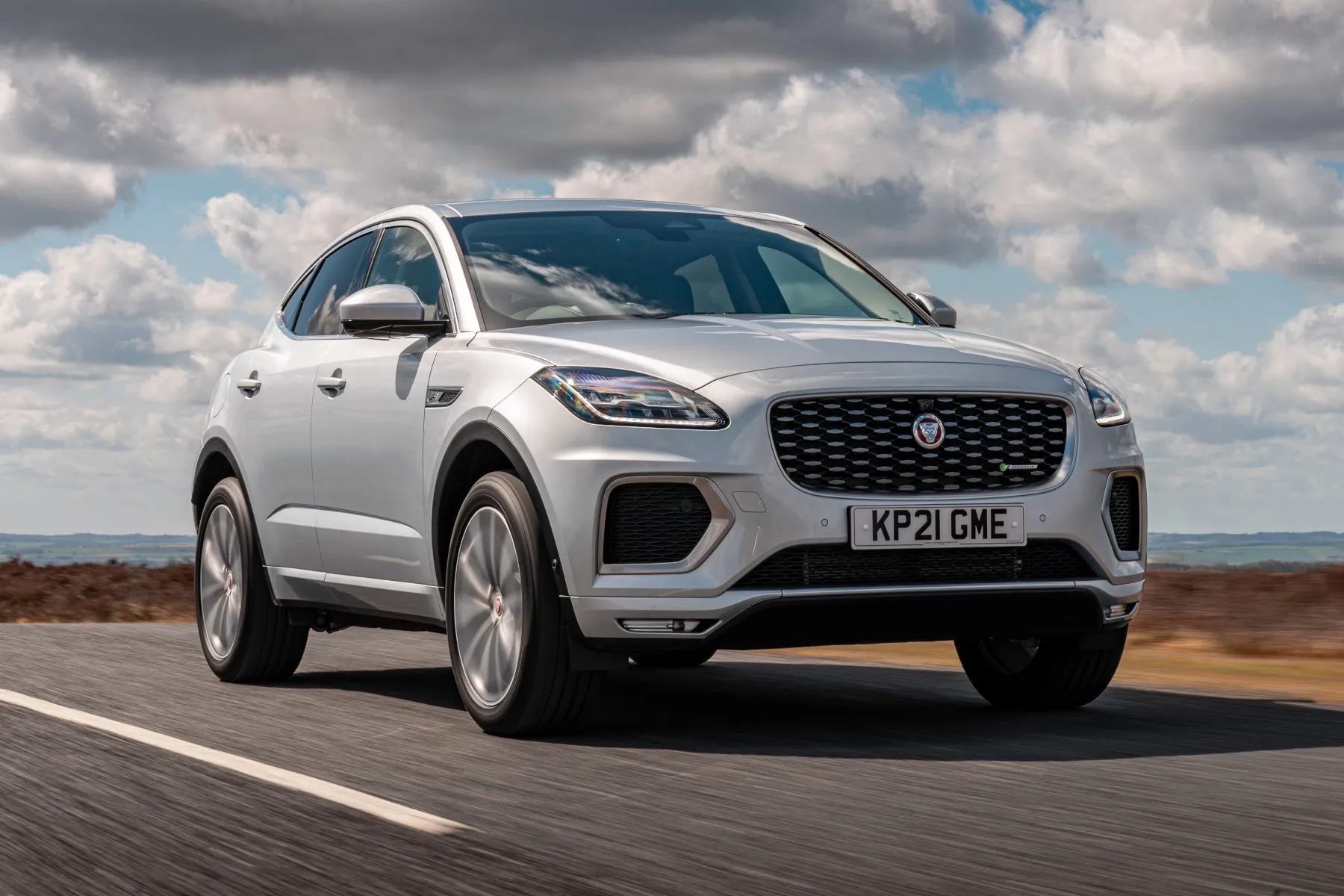
Jaguar took decades to launch its first SUV - the F-Pace - back in 2016, and it rapidly became the brand’s best-selling model. This Jaguar E-Pace review looks at the more more compact SUV in the range, the E-Pace. Jaguar also offers the all-electric i-Pace at the top of the range, commanding a higher price for green power.
It competes against a wide variety of premium rivals, including the Volvo XC40, Range Rover Evoque, BMW X2, and Audi Q3, to name just a few. The Jaguar brings to the table a sporty design inspired (loosely) by the F-Type sports car, and a choice of petrol and diesel engines. some with hybrid tech depending on which you choose.
Diesels range from 150PS to 240PS for used buyers, with the final versions using a 204PS 2.0-litre turbodiesel with mild hybrid assistance. The petrols currently start with a 269PS 1.5-litre petrol with plug-in EV help, while used buyers can go all the way up to a 300PS 2.0-litre petrol. All but the least powerful diesel models are fitted with four-wheel drive as standard, and most variants also come with a nine-speed automatic gearbox, although there’s also a six-speed manual available on the less potent diesel models.
Unfortunately, the Jaguar E-Pace doesn't live up to its sporty styling and it doesn’t feel especially agile. It's relatively heavy, rolls in corners and has inert steering that doesn’t inspire confidence, even if it does have plenty of grip. That wouldn't usually matter in an SUV but Jaguars have a reputation for sportiness that isn’t adhered to here – the larger F-Pace is much more accomplished in this regard.
Its portly weight also blunts the Jaguar E-Pace’s performance. The entry-level diesels feel ponderous, and only the most potent models - which are thirsty on fuel - build momentum with any real urgency. For us, the relaxed D200 diesel automatic is the pick of the bunch, especially if you do a lot of motorway driving.
This engine did struggle to compete with its rivals for efficiency, though the addition of mild-hybrid technology to help it save fuel has evened up the score.
The news isn’t much better when you consider the Jaguar E-Pace’s interior. It feels plasticky and, although it’s a five-seater, the middle seat in the back is set quite high, with a narrow base and nowhere to put your feet. It’s much better sampled with four on board.
The Jaguar E-Pace has plenty of clever interior storage which makes up for the fact it’s boot isn’t as large or as flexible as in rivals such as the BMW X1.
Entry-level models all have LED headlights, a 11.4-inch media screen (previously a 10-inch item), climate control and all-round parking aids.
There's little need to go beyond the S grade with a new E-Pace. It brings sat-nav and full smartphone integration, plus luxuries such as leather upholstery and electrically operated seats and a smooth-shifting auto gearbox.
Even in higher trims, though, the Jaguar E-Pace lags well behind rivals. Okay, so it looks sporty, but the driving experience doesn’t live up to the exterior styling, the car’s expensive to run, feels dated inside and isn’t as practical as rivals. Sadly, the entry point to Jaguar’s SUV range is the model most worth avoiding.
Looking for a used car for sale? We've got 100s of Jaguar Approved Used Cars for Sale for you to choose from, including a wide range of Jaguar E-Pace cars for sale.
Is the Jaguar E-Pace right for you?
The answer to this rather depends on what you want from your compact SUV. The Jaguar E-Pace is handsome, but feels lead-footed compared to its premium rivals, is quite pricey in its higher specifications, and is less economical than many other SUVs in this price range.
It trades more on its looks and the strong appeal of its badge than anything else, but the market does reflect this and there are some great deals on used and pre-registered cars. At the right money, the E-Pace starts to make a lot more sense.
What’s the best Jaguar E-Pace model/engine to choose?
Despite the athletic looking exterior, underneath the Jaguar E-Pace is on the heavy side for a compact SUV. This means it feels slower than other cars with a similar power output.
That takes the entry-level D150 diesel and P200 petrol off the table for used buyers. While the front-wheel drive, manual versions of the former are the most efficient, they're not the smoothest to drive, and too slow to recommend.
Instead, we would step up to the D180 paired with the optional nine-speed automatic. This combination plays to the car's strengths as a cruiser, and while not especially quick, it is more effortless than the D150 model. Pick one up in S trim and you'll have a luxurious, capable four-wheel drive car that sneaks under the £40,000 barrier - saving you a packet on road tax - but you'll have to skip the R-Dynamic pack to keep below that limit.
For those buying new, the D200 with its 204PS 2.0-litre engine, mild hybrid assist and automatic gearbox are all you need. However, some will find the claimed 37-mile EV driving range of the P270e plug-in hybrid model appeals if they cover shorter journeys and can recharge the car readily.
What other cars are similar to the Jaguar E-Pace?
Few cars are closer to the Jaguar E-Pace than its sibling from sister brand Land Rover, the Discovery Sport. It unfortunately is the favourite child of the pair, with a smarter cabin and equally sharp looks. It's a seven-seater, though, so the Range Rover Evoque is a more comparable model.
Further afield, the BMW X1 offers a more hatch-like driving experience, exceptional build quality and class-best infotainment, but generic looks, while the Volvo XC40 oozes Scandinavian style, is comfortable and practical.
For the same money as a mid-spec E-Pace, you could upgrade in size, getting yourself an Audi Q5. That car is lighter, faster, and more refined, along with having a bigger boot and fantastically roomy interior.
At the lower end of the spectrum, it's hard to ignore the value you get from cars like the Volkswagen Tiguan. It feels better built and more modern insider than the Jaguar, yet is cheaper to buy and run.
Comfort and design: Jaguar E-Pace interior
"The design inspiration from the F-Type sports car comes across loud and clear inside Jaguar's smallest SUV. Its driver-focused cabin makes it feel suitably sporty and matches the sharp exterior."
It features a chunky grab handle on the centre console that's lifted straight from the two-seater, and the sleek wraparound dash and high window line make it seem like you’re sitting lower in the car than you actually are.
Forward visibility is excellent, but the curvy design wreaks havoc with the rearward view. The shallow screen and thick pillars at the back make reversing tricky, and you'll find yourself relying on the camera and sensors to avoid bumps.
The interior is intuitively laid out. Three oversized dials in the centre of the stack operate the air-con and heater. Above them is a, 11.4-inch (formerly 10-inch) screen that's standard fit on all versions, mounted flush with the dashboard, although the angle it's fixed at does create some glare in bright sunshine.
Apart from the electronic handbrake being hidden away by the driver's right knee, most people won't find it taxing to work out where everything is, and both the standard analogue and optional digital dials are clear.
All but entry-level cars feature electric seat adjustment, so it’s easy to find the right driving position, and the seats are grippy and supportive, whilst remaining comfortable.
It's a shame that you have to step-up to pricier Jaguar E-Pace SE trim when buying used to get lumbar support, as this helpful feature can be the difference between hopping out relatively fresh from a long drive or nursing a stiff, sore back.
Quality and finish
Although it all looks smart enough, material quality in the Jaguar is one rung below what you’ll find in most of its rivals. Lower down in the cabin in particular, the hard plastics used don’t stand up well to closer scrutiny.
Even areas that should feel really solid - the infotainment screen surrounds for example - feel hollow and will creak if prodded firmly. Not a very encouraging sign in what is supposedly a very posh, premium product.
The leather on the steering wheel and (from S trim onwards) seats feels suitably plush, and you'll find some attractive faux stitching on the chunky grab handle on the centre console. Jaguar E-Pace R-Dynamic models (which is standard kit on later versions) add some bling details like bright metal pedals and illuminated scuff plates in the doors, enhancing the sporty interior theme.
Top spec Jaguar E-Pace HSE models feature super soft 'Windsor' leather seats, but adding such opulent extras only highlights the patchy quality of other parts of the cabin, whereas German SUVs feel consistently solid.
Thankfully, this is an area that Jaguar improved in the 2021 facelift, but the E-Pace still felt off the pace next to key rivals.
Infotainment: Touchscreen, USB, nav and stereo in the Jaguar E-Pace
Every Jaguar E-Pace started out with a 10-inch Touch Pro screen, punchy six-speaker Hi-Fi, DAB radio and Bluetooth. This display has clear graphics, bright colours, and fairly snappy responses. The menus are intuitive, and Jaguar anchors all the on-screen shortcut buttons to the lower edge of the screen so that they're easier to reach. Trouble is, they're little and tricky to hit.
However, it was a little tight-fisted of Jaguar to leave smartphone mirroring (via Android Auto and Apple CarPlay) on the options list. It comes standard on S models, and allows you to hijack that nice big screen to use with your favourite navigation, streaming and messaging apps on your smartphone. This model also includes a built-in navigation system, on-board Wi-Fi and connected services like live traffic updates.
Step up to SE trim, and you get a brilliant Meridian sound system with powerful, rich sound, while top spec versions replace the analogue dials with a larger 12.3-inch digital display, although this comes as standard on rivals such as the Q3 and XC40.
Still, unlike the Volvo XC40 and Range Rover Evoque, there are separate physical controls for the climate and heater settings, with a large digital read out in the dials making it a doddle to fine-tune the temperature.
Those buttons remained with the 2021 facelift and Jaguar upped the infotainment game with the Pivi Pro media system, which became standard on all E-Pace models and is leagues ahead of the old system. It uses an 11.4-inch display featuring sharp graphics and lightning quick responses. Smartphone integration in the form of Apple CarPlay and Android Auto is standard, too - so you can stream your Spotify soundtrack or navigate using Waze without having to use your phone.
Whichever E-Pace you choose from the updated range from 2021 onwards, you'll get an interactive driver display in place of the previous analogue dials behind the steering wheel. Just like the premium media system, this is brilliant, with sharp, clear graphics displaying everything you could possibly need. For the ultimate in in-car entertainment, look for a model with the premium Meridian sound system, which means skipping the base S trim.
Space and practicality: Jaguar E-Pace boot space
One of the main reasons buyers flock to SUVs is because they offer plenty of space and versatility. Despite its relatively compact footprint, the Jaguar E-Pace feels roomy inside, especially for those up front. There's ample headroom (even for the tallest of drivers) and plenty of well-placed cubbies for your odds and ends.
Special mention goes to the cavernous glovebox, which could easily swallow a handbag, and door pockets with neat moulded cutouts for drinks bottles. If that's not sufficient, you can open up the central armrest to uncover another large cubby, with a pair of USB ports.
In the back, two adults can fit comfortably. Headroom is reasonable, but a six-footer sat behind an equally tall driver will find their knees resting on the seat backs. Unlike many rivals though, the back seats are fixed, so you can't slide or recline them to free up load space. Adding a third is a squeeze.
Ignore the Jaguar E-Pace's official 425-litre boot capacity - Jaguar measures luggage space in a different way to most brands - which means once you get the tape measure out and compare them like-for-like, it will carry less than most SUVs. At least the boot has a square shape, no load lip and some useful additional storage space under the floor.
Flexibility is not the best, though. The Volvo XC40, BMW X1 and Volkswagen Tiguan come with a three-way 40:20:40 seat configuration – so you better juggle passenger and boot space – in the E-Pace you get a far more conventional 60:40 split to maximise boot space to 1234 litres.
In exterior dimensions the Jaguar E-Pace is smaller than the Volvo XC40 at 1648mm tall and 4395mm long but it's a touch wider at 2088mm with the mirrors folded out.
Handling and ride quality: What is the Jaguar E-Pace like to drive?
"We've mentioned this already, but it's worth repeating that the Jaguar E-Pace is quite heavy for its size and that has an impact on the way it rides and handles."
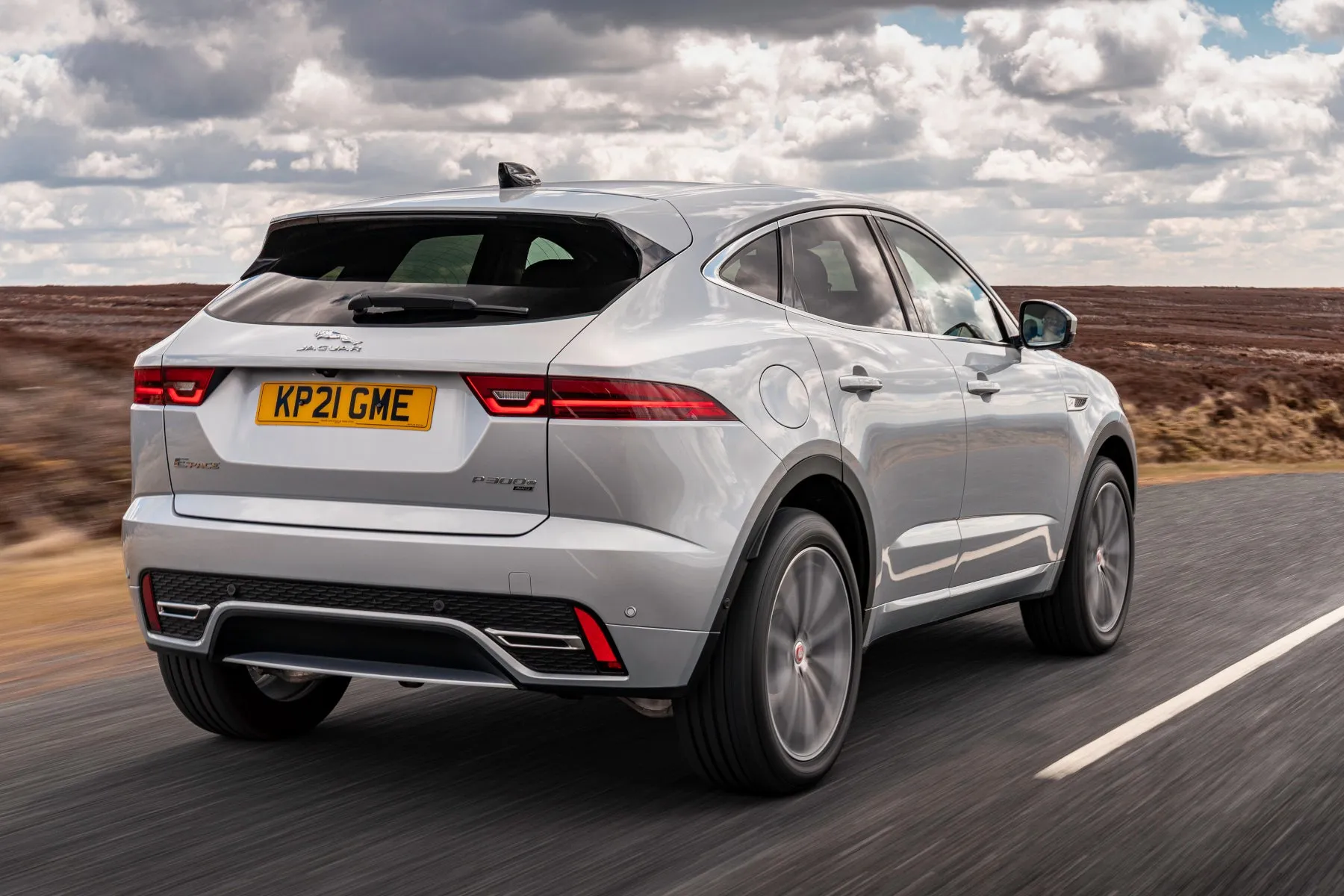
All Jaguar E-Pace models come with Adaptive Dynamics if you wish to tweak the suspension to your liking. Also known as adaptive suspension or Configurable Dynamics, this can increase the firmness of the suspension’s dampers in Sport mode, or soften them in Comfort mode. With Comfort mode selected, the E-Pace rides beautifully over broken roads as the dampers are constantly adjusted to provide the most balanced ride.
What engines and gearboxes are available in the Jaguar E-Pace?
Jaguar has offered plenty of different combos of engine, gearbox and drivetrain. That sounds daunting, but in fact it's deceptively simple. It started out with a pair of 2.0-litre four-cylinder turbos (one petrol, one diesel) in a variety of outputs.
Diesels are badged D150, D180 and D240. The D150 is the only E-Pace offered with front-wheel drive - but only in conjunction with a six-speed manual gearbox - all other versions send their power to all four corners.
Petrol models also come in three flavours – P200, P250 and P300. All have four-wheel drive and a nine-speed automatic gearbox as standard, that’s an option on the entry-level diesels.
Buyers who are more interested in fuel economy than performance will be fine with the entry-level D150. It has just enough grunt to make progress, but never feels quick. Avoid the manual gearbox though, it severely blunts performance and is ill-suited to the car's relaxed nature.
The nine-speed automatic is best when left to its own devices, but in R-Dynamic cars you get shifter paddles on the steering wheel if you want to take over. It's a bit dim-witted though, often taking too long to kick down.
Still, if you want to make swift overtaking manoeuvres, regularly tow a caravan, or will regularly have the car fully-loaded,, the D180 is a better all-rounder. It's stronger than the quickest petrol in-gear, but far less thirsty on fuel. The twin-turbo D240 is even more potent on paper, but in real world driving the difference is fairly marginal.
The petrol engines are impressively smooth and quiet at low revs, but sound a bit harsh when extended. If you want them to feel quick, you have to push them hard, and their already poor economy gets even worse.
Then, for 2021, Jaguar revised the engine line-up with four petrol power outputs and two diesel power options, all with hybrid assistance except the most basic diesel. This lot was then pruned further to a single 204PS diesel with hybrid help in the D200 and the 269PS P270e with plug-in hybrid assist. The plug-in petrol has an EV driving range of up to a claimed 37 miles. The 1.5-litre engine in the P270e works better than its small size might suggest, so it's a sound bet for those seeking a newer E-Pace.
Refinement and noise levels
Choose any of the diesels, and hard acceleration when overtaking or joining the motorway will be accompanied by a fairly gruff soundtrack, and vibrations through the steering wheel.
Once it settles into a cruise however, the engines quieten down, and you can make fairly serene progress. The Jaguar E-Pace generates less tyre roar than a BMW X1 or X2, although that’s not saying a great deal.
Wind noise is less well suppressed, but rarely becomes intrusive. The petrol engines are quieter, and pull more cleanly than their diesel counterparts, although the highly tuned P300 gets a bit droney at higher revs. In Dynamic mode it pipes exhaust noise into the cabin via the speakers, but it's more irritating than sporty.
It’s also worth noting that car’s fitted with the six-speed manual gearbox suffer from more engine noise when cruising.
Safety equipment: How safe is the Jaguar E-Pace?
As you would expect of any modern, premium vehicle, the Jaguar E-Pace received a maximum five-star safety rating from crash testers Euro NCAP. It did well in all four test categories, especially child protection.
However, a closer look at the individual scores reveals that it did worse than most rivals for adult protection. It was awarded just 87% (rivals like the Volvo XC40 get 97%) partly due to poor whiplash and driver ratings.
These are fine margins, but another area where the Jaguar E-Pace gets edged out by its peers. It's not because of a lack of safety equipment though. Every model comes with automatic emergency braking (AEB) that senses any oncoming obstacles, will warn the driver of potential collisions, and can stop the car to help prevent one.
That's just one part of an impressive kit roster that includes a lane keep assistant, an airbag under the bonnet to protect pedestrians if they're unfortunate enough to go over the bonnet, and a clever system that will monitor your driving style, warning you to take a break if your attention is judged to be faltering.
All but the entry-level older models get a traffic sign reader, that can work with the cruise control to always keep the car at or below the legal limit. This is now standard on all E-Paces bought new.
Travel up the range, and used models like the SE includ a Park Pro Pack that adds a set of 360º cameras to the usual sensors, while top spec HSE models get adaptive cruise control that can brake and accelerate the car for you. With a new E-Pace, the base S trim misses out on a blind spot monitor and rear traffic monitor and rear collision monitor.
MPG and fuel costs: What does a Jaguar E-Pace cost to run?
"One area the Jaguar E-Pace struggles to compete is fuel efficiency. It weighs more than the larger F-Pace, and with a heavy four-wheel drive system standard on most, so most petrol versions will barely return more than 30mpg, usually less."
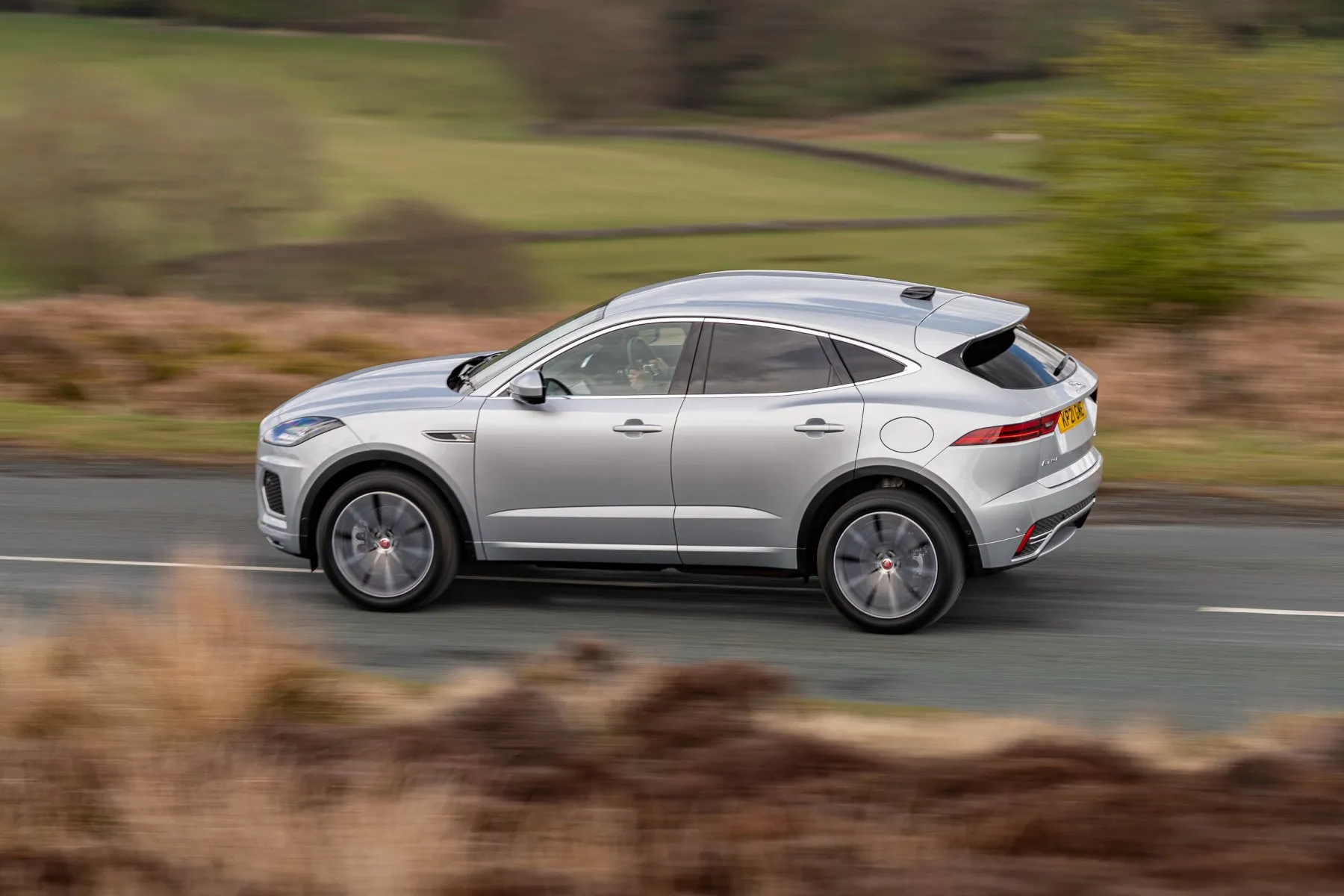
The P270e plug-in hybrid addresses this with a claimed combined economy of 187.3mpg and 37-mile EV driving range, though 50mpg is more likely in daily use unless you charge the battery at every opportunity.
The latest D200 MHEV turbodiesel has an nine-speed auto and claims 43.7mpg, which is a bit ho-hum in this class even if it does have all-wheel drive included.
Pick a diesel with the manual gearbox, and the E-Pace claimed 42.4mpg for the front-driven D150, at least according to official figures. Adding four-wheel drive drops that down to high thirties, whereas a BMW X1 or Audi Q3 get closer to 50mpg.
How reliable is the Jaguar E-Pace?
Jaguar made fifth spot out of 29 manufacturers in the latest HonestJohn.co.uk's Satisfaction Index with a score of 90.5% satisfaction.
Insurance groups and costs
Finding cover for your Jaguar SUV will cost a little more than it would in its premium rivals. The cheapest versions are the D150 diesels with manual gearboxes. They start off in insurance Group 25 in standard trim.
The D180 model jumps up to Group 29, while the brawniest D240 is right up in Group 35. Compare that to the BMW X2 or Volvo XC40, which both start off three bands lower in Group 22 in a similarly spec diesel car.
Picking a petrol means steeper premiums. The P200 starts off in Group 31, the P300 is right up in Group 39. That goes up further to group 42 for the plug-in hybrid models.
Things look even worse for the Jaguar E-Pace when you compare it with, say, a Volkswagen Tiguan. The fastest 240PS twin-turbo diesel version of this car sits almost ten groups lower than the equally powerful D240.
VED car tax: What is the annual road tax on a Jaguar E-Pace?
No Jaguar E-Pace bought new manages to sneak in under the £40,000 barrier. These cars will all pay the standard £190 fixed rate of road tax (VED) plus the £490 levy on cars that exceed this value.
Some good news is the P270e emits just 33g/km, so you'll pay first year road tax of zero as it qualifies as an alternative fuel vehicle (for the time being). After the first year, you'll pay £180 thanks to a £10 discount due to its alternative vehicle status.
How much should you be paying for a used Jaguar E-Pace?
"Buying used makes a lot of sense thanks to decent savings over a new Jaguar E-Pace."
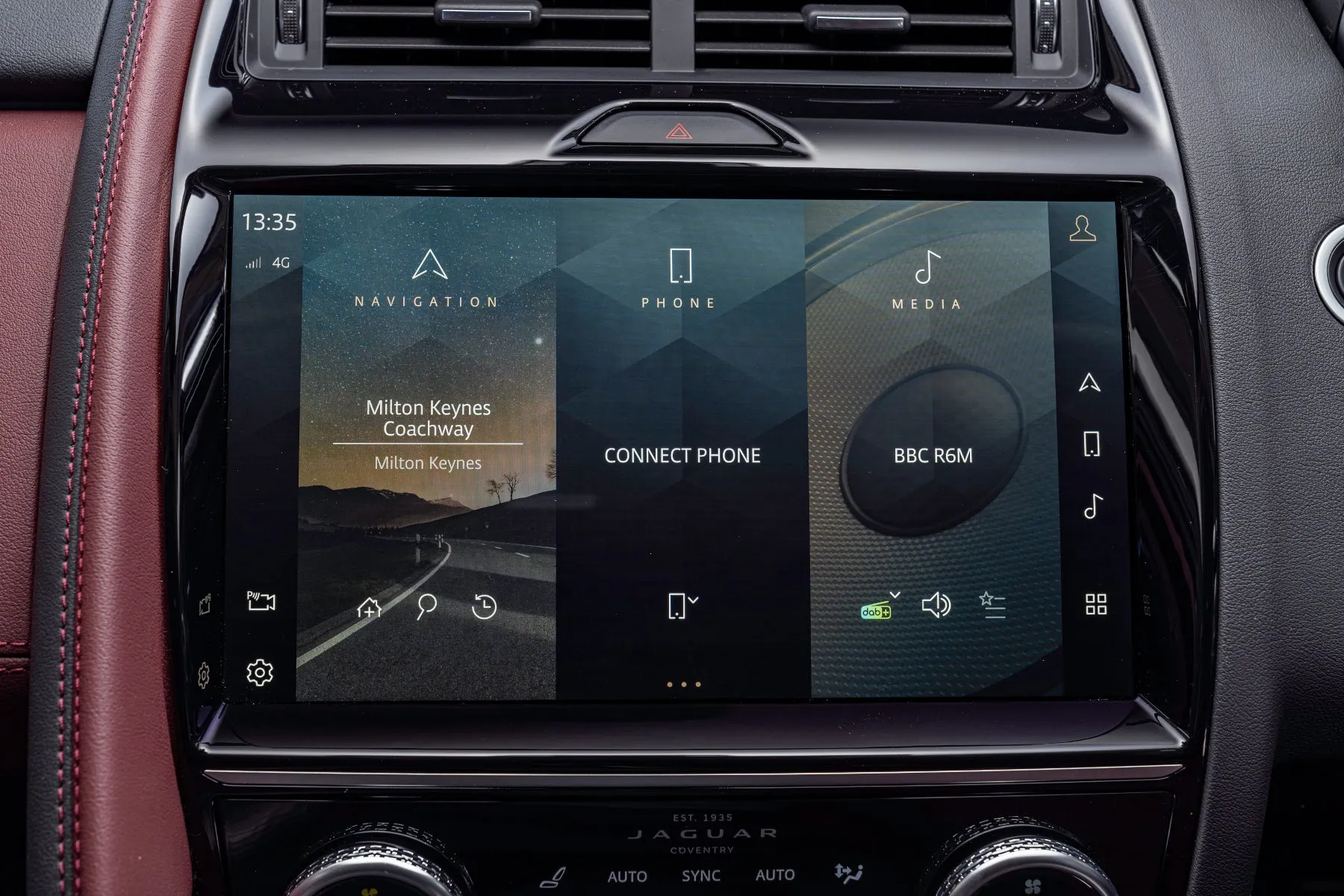
A six-year old E-Pace in D150 spec with the manual gearbox, and with a modest 30,000 miles travelled, with cost around £16,000. Opting for the same car but with an automatic transmission will require a further £500 in your budget calculation.
If you want four-wheel drive, reckon on spending from £17,000 for a D180 of similar age and mileage.
For those wanting a new E-Pace, a pre-registered or ex-dealer demo are the ones to look for to bag a bargain. An example with less than 3000 miles on the clock could be yours for £40,000 in SE Black trim, saving you £6000 on the list price.
Trim levels and standard equipment
With the most recent Jaguar E-Pace line-up, you have a pick of three trims: R-Dynamic S, R-Dynamic SE Black, and R-Dynamic HSE Black. Those word salads essentially correspond to the older S, SE, and HSE trims.
With the R-Dynamic S, you get 18-inch alloy wheels, LED geadlights, heated windscreen and washers, and a power tailgate. It has Jaguar's Configurable Dynamics and Adaptive Surface Control, as well as cruise control and rear parking camera. Inside, you'll find DuoLeather upholstery, sports seats, and 12-way electric adjustment for the driver's chair (10-way for the passenger), plus the 11.4-inch Pivi Pro infotainment system.
The R-Dynamic SE Black ups that with its R-Dynamic exterior styling and gloss black detailing. There's a fixed panoramic glass roof, and keyless entry. 19-inch wheels are fitted to this model, as well as more safety kit and the Meridien Sound System.
With the R-Dynamic HSE Black, you get all of the SE's kit plus Windsor leather upholstery and 16-way electric adjustment for the heated and cooled front seats.
The first thing you'll need to decide when picking your used Jaguar E-Pace is how you'd like it to look inside and out. Where some brands separate styling by each trim level, Jaguar used to offer two options, standard or R-Dynamic.
The latter acts as a ready-made sporty makeover. It packs in different alloy wheel designs, glossy black interior trim, and sharper bumpers to help it stand out.
To either of these starting points, you can then add either the S, SE, or HSE specification pack. Every car is already fairly well equipped. The baseline trim includes LED headlights, 17-inch alloys, a heated screen and front seats, reversing camera, climate control, plus a six-speaker stereo with a slick 10.0-inch touchscreen.
Add the Jaguar E-Pace S pack (which we recommend doing) to get leather seats with electric adjustment, sat-nav and full Apple and Android smartphone integration via CarPlay and Auto software, and a handy traffic sign reader.
Mid-range Jaguar E-Pace SE could be worth stretching to though, as it includes useful convenience features like a powered tailgate, a rather nifty 360 degree parking camera, and a Meridian Hi-Fi with amazing sound quality.
We would stop short of the top Jaguar E-Pace HSE though, as it’s prohibitively expensive. Although it benefits from softer leather, a 12.3-inch digital driver’s display, keyless entry, and a comprehensive suit of driving aids.
Jaguar introduced the Chequered Flag special edition in 2019. It takes the sporty styling of the Jaguar E-Pace R-Dynamic, and weaves in lots of choice goodies from higher up in the range. It's available in three colours, grey, white, or a striking photon red, a colour that is unique to this model, but it's priced above the already expensive SE.
Apart from the kit we've already mentioned, options such as the £990 fixed panoramic glass roof that let more light into the cabin, additional USB power sockets in the rear (£160) plus a set of loadspace dividing storage rails for stopping stuff rolling about in the boot (£295) are worthwhile upgrades.
Ask the heycar experts: common questions
What is the difference between the Jaguar E-Pace and the F-Pace?
Is the Jaguar E-Pace a hybrid?
How much boot space does the Jaguar E-Pace have?
Is the Jaguar E-Pace a good car?
Get our latest advice, news and offers
Keep me updated by email with the latest advice, news and offers from heycar.
By submitting you agree to our privacy policy
